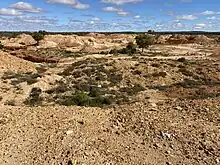
The Yowah Nut is a type of precious opal, found within the Yowah opal fields situated in Yowah, Shire of Paroo, South West Queensland, Australia since the latter part of the 19th century.[1] These opals are known for their distinctive nut-like shape, opalescent patterns, and vibrant colours.
Geology and formation
Yowah, an opal mining town with a population of 126,[2] is known for its Yowah Nuts. The Yowah opal field is characterized by the presence of ironstone concretions, which serve as the host material for the opal deposits. Yowah nuts are a type of precious opal, which is a hydrated form of silica. They are formed through a natural process that involves the percolation of silica-rich water into cavities and voids within ironstone concretions. Over time, the silica deposits accumulate and solidify, creating opalescent patterns.[3] Bryan Rossiter discovered them before becoming the manager of the Southern Cross Mine,[1][4] registered in Yowah on 1 September 1884.[1] Characterized by its unique resemblance to a "nut," the Yowah Nut distinguishes itself from other opal formations.[5] This distinct shape arises from a natural process involving the substitution of organic material with opal. Over time, the original matter, often a fossilized shell or wood, undergoes decay, leaving behind a void that is subsequently filled with opal. The rarity is due to only one in 10,000 Yowah Nuts contain opal.[6] The opalization process imbues the interior of the void with an assortment of hues and designs, giving rise to the array of colours including blue, green, red, yellow, and orange. These are highlighted by flashes of iridescence that transform as the angle of observation shifts. This optical phenomenon, referred to as "opalescence," which augments the gemstone's allure and value.[5]


Conservation and mining
Mining for Yowah Nuts requires delicate handling, as they are often encased within hard ironstone.[7] Conservation efforts are required to ensure their sustainable harvesting. The Queensland Government has produced wetland mapping to identify and map flora and fauna in the area to provide greater protection.[8]
References
- 1 2 3 "Yowah Opal Nut". Smithsonian National Museum of Natural History.
- ↑ "2021 Census Yowah". Australian Bureau of Statistics. Retrieved 29 August 2023.
- ↑ Rey, Patrice (3 May 2013). "Opalisation of the Great Artesian Basin (central Australia): An Australian story with a Martian twist". Australian Journal of Earth Sciences.
- ↑ Rands, William H (1 May 1902). "The opal mining industry and the distribution of opal deposits in Queensland" (PDF). Geology Survey Office Brisbane – via Queensland Government.
- 1 2 ""YOWAH NUT" OPAL IN THE SMITHSONIAN'S GEM COLLECTION". GIA Gem Encyclopedia. Retrieved 7 September 2023.
- ↑ Voiculescu-Holvad, Christian (January 2018). "The Opalised Fossils of Australia: Mineralogical and Paleontological Treasures from the Australian Outback". ResearchGate. 1: 25.
- ↑ "Chasing the Rainbow: Australia Opal Fields Expedition". Gemological Institute of America. Retrieved 29 August 2023.
- ↑ "Wetland mapping — Yowah 100K map tile — 7841". Queensland Government Wet Land Information. Retrieved 29 August 2023.
Further reading
- Eckert, Allan, ed. (1997). The World of Opals. Wiley. ISBN 9780471133971.